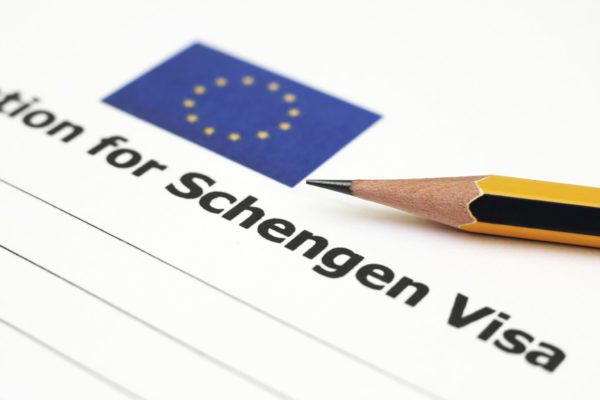Schengen multiple entry visa
Long-term Schengen for Russians starts with a single entry. It is difficult to obtain a multiple visa without having any trips to Europe under your belt. Basically, permission is issued to those who have actively traveled in the last three years and can document this. A long-term multiple visa is issued for a period of 1 to 5 years. How to obtain a Schengen visa for a long stay can be found on our website.
Having received the Mult stamp, you can cross the border multiple times (travel to Europe and return to Russia). 26 countries of the Schengen zone will be open to you; you will be able to travel within the EU without presenting national visas at the borders.
What a multiple visa is and why it is needed can be found out by studying the EU Visa Code. First of all, this is permission to enter and the right to reside in the EU for a certain period of time. Having received a stamp, you will not be able, for example, to get a job if you did not apply for a work or study visa, if you did not apply for a student visa. There are different categories and types of visas, it is advisable to study them before preparing documents to submit to a visa center or consulate.
How much do the services and the Schengen registration procedure cost?
If you apply for a category C tourist visa yourself, the consular fee will cost 35 euros. You will also need to pay a service fee of 11-15 euros to the visa center of the European country where the trip will be made. This price does not depend on the state that will issue the visa. It is worth noting that children under 6 years of age, as well as disabled people, are exempt from payment.
In order to obtain education or get a job, you should apply for a special national visa D or residence permit, which will be issued by the specific country where you want to study or work.
You can also, if you are running out of time and have the funds, provide a Schengen visa for 5 years to special companies, and for a period of less than three years - to travel agencies. In a travel agency, the cost of a long-term Schengen visa will, of course, be higher, but you can avoid queues and various bureaucratic delays, since such organizations have their own connections and various business contacts with embassies and consulates.
The price of a Schengen visa may change depending on the complexity of registration in a particular country and when legislation related to the visa regime and the acquisition of permanent residence changes in these countries.
The concept of a visa corridor
This concept refers to the period during which you are allowed to visit the country. In other words, these are the deadlines indicated on the visa stamp in the passport. On average, the visa corridor is three months, which must be chosen in six months, a year and longer periods. You can calculate how many days you have left using a special online calculator, which includes the dates of departure and entry.
Which country gives the longest Schengen visa is often asked by those who are planning to apply for a multiple visa. A simplified procedure is offered by Finland, Latvia, Greece and Slovakia, Spain and some countries in Southern Europe that are concerned about the development of tourism. But even in this case, refusals are quite possible if you were careless in preparing documents or filling out the application form.
There is also a list of countries where it is most difficult to obtain a visa. These include, for example, Switzerland, Great Britain, Italy, Denmark, Austria. Belgium, Norway, Sweden and Estonia show high refusal rates. This does not mean that you should not even try to apply for a multiple visa to the embassies of these countries. It’s just worth assessing your chances more carefully, and if the result is important to you (for example, an important meeting or contract could be disrupted due to a refusal), then it may make sense to entrust the preparation of documents to professional intermediaries.
Types of long-term Schengen

There are 2 categories of long-term stamps:
- "C". Its holders can safely stay in the country for up to 90 days once every six months. During this period, free movement throughout Schengen is allowed, but within the period established in the document.
- "D". Long-term, with extended periods of more than 90 days of stay on the territory. Suitable for those who have planned a long stay in a specific Schengen country. However, the requirements and rules for each country are established individually. Since 2010, citizens who have received this type of document have the advantage of residing in a certain country, but also freely traveling to other territories of the Schengen zone.
Important! Tourists are prohibited from exceeding the specified period of stay in the Schengen state, so that in the future there will be no problems with extending the document.
- How is a Schengen visa different from a regular visa?
What factors influence the duration of a visa permit?
You can apply for a multi-Schengen visa only if a number of conditions are met. Firstly, if you have a visa-free passport, this is not done immediately, but over a long period of time. First, you will have to apply for a single-entry visa, then a multiple-entry visa for a short period (6 months and a year), and only then you can apply for a multiple visa. Secondly, you must have a reason to visit Europe frequently; regular tourism is not such a reason.
The issuance of a multiple visa is affected by:
- social status (income, profession, presence of business);
- experience in obtaining EU visas;
- the number of border crossings through the border points of the country where documents are submitted;
- experience of deportations or criminal history;
- purpose of travel.
The decisive factor for obtaining a visa, for example, for a journalist, will be accreditation (at a festival or other event). For future students, a certificate of admission to the university and a paid training contract will play a role. The green light to obtain long-term visas is also given to those whose work requires constant travel and who often travel to Europe.
Each specific case has its own characteristics. They need to be taken into account when submitting documents in order to increase the chances of receiving a stamp in your passport.
In 2011, an updated version of the EU Visa Code came into force, which provides for different rules for issuing multiple visas. Now this is done much easier, but the principle of gradualism must be observed (single-time ones are issued first, and only then multiple-time ones). The maximum period of stay in Europe remains the same - 90 days within 180 days.
Multiple resolution
When thinking about how to get a long-term Schengen visa, it makes sense to decide on its type. The most popular types of visa are C1, C2, C3, C4, which are issued mainly to tourists and those visiting relatives or friends in Europe.
C1 is issued for a period of up to a month (usually for the purchased tour), C2 and C3 for six months to a year, and C4 for a minimum of a year, but the maximum can be issued for a period of 5 years. Visas can be single, double or multiple entry, i.e. with the possibility of frequent exits and entries into the country. The D visa can also be issued for up to 5 years and, unlike the C4, you can stay for more than 90 days.
What types of Schengen visas are there:
- for travel and recreation;
- for treatment in European clinics;
- for meetings and communication (for example, with relatives);
- for work and study;
- to open your own business;
- for the purchase of real estate and other assets (investor visa);
- for conducting tours and participating in competitions.
Having chosen the desired visa option, you can study the package of documents required by the embassy. It usually includes a passport, a completed application form, insurance and photographs, as well as documents to confirm the purpose of the visit and your financial ability to pay for it.

Having received a multiple-entry D visa, you actually take the first step towards obtaining a residence permit, so applicants are assessed very strictly. Even if you are not planning to emigrate, theoretically, after frequent visits to the EU, such plans may well appear. With an established visa history, i.e. Frequent departures and entries into the country, the possibility of obtaining a residence permit card is noticeably simplified.
A residence permit gives the right to long-term residence in a European country and, with the exception of the inability to vote in elections and be elected, is not much different from citizenship.
Semi-annual multistamp
How to get a Schengen visa for six months is often asked by those who like to go on vacation not once, but twice a year. It is issued to those who have already received single or double entry visas in recent years. The number of past trips is not limited, but it is desirable that there be at least two.
Each embassy may have its own rules, for example, to obtain a multiple visa to the Czech Republic, it is enough to have at least one exit. The six-month Schengen visa is the easiest to apply for. If you comply with all requirements for submitting documents, then the risk of refusal is minimal. The exceptions are citizens with recent refusals of a Schengen visa, persons who were unable to confirm income or purpose of the visit. Having issued a six-month stamp, you can stay in the EU for 90 days. In fact, the name reflects the time period during which you can enter and exit the country without issuing new permits.
Obtaining a multi-Schengen card for 2 years
A Schengen visa for 2 years is usually issued under different conditions. You need a compelling reason for applying for such a long period of time and experience in obtaining annual visas in the past. All trips to the EU must have taken place without violating the visa regime (expired visas, deportation, violation of rules for transporting goods).
Two annual visas in the passport for the last 2-3 years is the highest level of requirements and not all embassies set it. Eastern European countries often issue a two-year visa to those who simply travel frequently to Europe with a multiple entry visa or a single entry permit.
But Sweden, Germany and Italy may require annual visas in the passport. One-year and two-year visas are issued mainly for guest, tourist or medical purposes. This is also an excellent option for students who are not sure that they will be able to pass the session and not be expelled in the first few years of study.
The cost of obtaining a two-year Schengen visa ranges from 150-850 euros, if you use intermediaries. Doing it yourself can be much cheaper.
3 year stamp

Obtaining a Schengen visa for 3 years is quite possible if you already had annual multiple visas in the EU. The applicant will have to explain why he needs such frequent visits to the Schengen area (visits to relatives, investments, studies). This visa allows you to stay in Europe for at least 90 days in each half-year for three years. Ordinary tourists are rarely given such a visa; they are mostly given annual, less often two-year, visas.
The price of a Schengen multivisa for 3 years when issued at a visa company starts from 500 to 1200 euros. Urgent processing through intermediaries can be much more expensive. The most expensive cartoons are in Italy, Switzerland, Norway, and Belgium.
Five-year Schengen
Applying for this type of visa is usually not much different from the procedure for obtaining a three-year visa. Likewise, a minimum of two annual EU visas or other experience visiting Europe (with tourist or other short-term visas) is required. This is the most difficult visa option and is issued only if you are sure that it is necessary.
Who gives Schengen for 5 years:
- embassies where you have already issued visas several times;
- countries that are interested in the influx of Russian tourists and investors;
- states in which your closest relatives live.
Any visa center will tell you how much a Schengen multiple visa for 5 years costs. The cost of registration with intermediaries can reach 1.5-2 thousand euros. When submitting documents yourself, you will only need to pay a consular fee of 35 euros. When applying for long visas, refusals occur only in the most extreme cases. They are usually replaced by a stamp on the visa for a shorter period. As a rule, if a person has already submitted documents several times, the likelihood of errors is minimal.
However, the visa officer may not like the vague purpose of obtaining a long-term visa or be wary of the fact that you frequently enter or exit through border controls of the country for which the visa was originally issued. But if you have been traveling to the EU for a long time and have your own property or many relatives there, then the questions to you will be rather formal.
Many people do not really need an expensive multiple visa C for 5 years. It is easier to apply for a D visa with the possibility of extension in order to have the possibility of a residence permit and, for example, undergo training or work under a contract in Europe. C4 is more suitable for those who like to frequently visit relatives in foreign countries or for artists, athletes, and politicians.
Schengen visa for five years
On June 6, 2021, new rules for obtaining a Schengen visa were adopted. Innovations should make life easier for conscientious travelers. Currently, there are no uniform rules for issuing visas between the Schengen countries. Each state is guided by its own principles and rules. Therefore, Russians had to study statistics and apply for Schengen at the consulates of more loyal countries. For example, only France could issue a multiple visa for a five-year period. But the Austrian consulate in the vast majority of cases gave a visa only for the dates of travel, even despite previous annual visas from other Schengen states.

We recommend reading these articles:
Holidays with children in Turkey: where is the best place to go?
How to emigrate to the Czech Republic from Russia
New Year 2021 in the Czech Republic
The new Schengen rules from 2021 should eliminate these differences. A single system will apply to all countries. It looks like this:
- Obtaining three single-entry visas for the dates of travel (must be issued within two years);
- Obtaining an annual multiple visa;
- Obtaining a Schengen visa for two years;
- Obtaining a Schengen visa for five years (but provided that a two-year multiple visa was issued within the last three years).
The new order seems logical. Today, a Schengen visa for a year (90 days of visa in each half-year) does not guarantee that the next visa will also be annual, much less issued for two years. For periods of more than a year, multiple visas were issued only by France, Greece, Italy, and Finland. For other countries, as a rule, a period of one year was the maximum. From 2021, all Schengen countries must begin issuing visas for two and five years.
See also: Work in Poland for Russians vacancies 2021 without knowledge of the language
Of course, only bona fide travelers will be able to obtain a five-year visa. Along with increasing the period for which a visa can be issued, the European Commission plans to tighten the verification of applicants for obtaining it. Therefore, two conditions must be met:
- The terms of previous visas have not been violated.
- The purpose of the visa has not been violated. The rules for obtaining a Schengen visa for the purpose of visiting several countries remain the same. The main country of residence must be the country that issued the visa. That is, if the visa is Italian, then during its validity period you must visit Italy. Otherwise, you will not be able to count on an extension to your next visa.
Who is easiest to get a multiple visa?

The easiest way to get a long-term Schengen visa is for an experienced traveler with a good income. They also include businessmen who can demonstrate decent incomes, officials and diplomats (official and diplomatic passports), those with family connections in the EU, as well as valuable specialists (scientists, athletes and cultural figures). Standing apart from this list are drivers of international transport (buses, vans), who, due to their profession, often travel around Europe.
There is also an unspoken list of countries in whose embassies it is easiest to obtain Mult. All employees of travel companies know this list, although there is still no official confirmation of it; all embassies assure that they easily issue multiple visas to everyone.
Which countries provide Schengen for a year or more in 2021:
- Slovakia;
- Bulgaria;
- Czech Republic;
- Greece;
- Hungary;
- France;
- Finland;
- Spain.
In many countries, for example, in Spain, a preferential option for obtaining multiple visas is provided for investors who have invested at least 500 thousand euros - 2 million euros in the purchase of real estate or other assets in the country. In Greece, the amount of investment for an “investor visa” is much lower – 250 thousand euros.
An investor’s “golden visa” in many countries makes it possible over time to invite relatives to the country of residence, obtain a residence permit, and, after the expiration of the naturalization period, citizenship.
For Russians, the easiest way to obtain a visa is in Latvia, Finland, France, Greece, and sometimes Italy. There is a minimum refusal rate compared to other consulates and there are no excessive requirements for applicants.
Without knowing these nuances and, for example, applying for a multiple visa with an empty passport, you risk getting a refusal or a regular six-month or annual Schengen visa. But in the future, if you “roll back” your short visa normally without cancellation and other problems, you can apply for a long-term permit to travel to Europe.
Refusal of a visa
You can always appeal a refusal of a multivisa by writing an appeal in the first few months after receiving your passport with a written explanation. The new Visa Code obliges all consulates to report the reasons for refusal, so you can immediately understand why this happened.
If you believe that you have been unfairly treated, you can always appeal the refusal decision. The entire procedure may take at least 2-3 months. Particularly complex cases can be considered for up to six months. If you simply submitted an incomplete package of documents, then after waiting 3-4 months, you can submit the papers to the consulate again.











